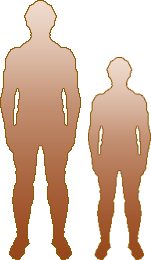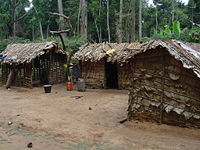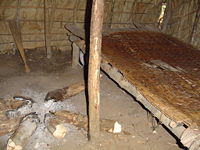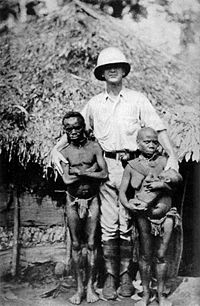Difference between revisions of "Pygmy" - New World Encyclopedia
From New World Encyclopedia
(copied from Wikipedia) |
m |
||
| Line 8: | Line 8: | ||
[[Image:Pygmy.png|thumb|right|Comparative height of a Pygmy man (right) and a European man (left).]] | [[Image:Pygmy.png|thumb|right|Comparative height of a Pygmy man (right) and a European man (left).]] | ||
| − | In an [[anthropology|anthropological]] context, a '''Pygmy''' is specifically a member of one of the hunter-gatherer people living in [[equatorial rainforest]]s characterised by their short height (below 1.5 [[metre]]s, or 4.5 [[feet]], on average). Pygmies are found throughout [[central Africa]], with smaller numbers in [[south-east Asia]] (see [[Negrito]]). Members of so-called Pygmy groups often consider the term derogatory, instead preferring to be called by the name of their ethnic group (e.g., [[Baka (Cameroon and Gabon)|Baka]], [[Mbuti]]). | + | In an [[anthropology|anthropological]] context, a '''Pygmy''' is specifically a member of one of the [[hunter-gatherer]] people living in [[equatorial rainforest]]s characterised by their short height (below 1.5 [[metre]]s, or 4.5 [[feet]], on average). Pygmies are found throughout [[central Africa]], with smaller numbers in [[south-east Asia]] (see [[Negrito]]). Members of so-called Pygmy groups often consider the term derogatory, instead preferring to be called by the name of their ethnic group (e.g., [[Baka (Cameroon and Gabon)|Baka]], [[Mbuti]]). |
The most closely studied group are the [[Mbuti]] of the [[Ituri Rainforest]] in the [[Democratic Republic of the Congo]], which were the subject of the study ''The Forest People'' (1962) by [[Colin Turnbull]]. Among the other African groups are the [[Aka (Pygmy tribe)|Aka]], [[BaBenzelé]], [[Baka (nomadic Central African people)|Baka]], [[Binga]], [[Efé]], [[Twa]], and [[Wochua]]. In the [[Central African Republic]], at least, the term [[Bayaka]] is preferred to Pygmy, as it refers to the people and not only to their stature. | The most closely studied group are the [[Mbuti]] of the [[Ituri Rainforest]] in the [[Democratic Republic of the Congo]], which were the subject of the study ''The Forest People'' (1962) by [[Colin Turnbull]]. Among the other African groups are the [[Aka (Pygmy tribe)|Aka]], [[BaBenzelé]], [[Baka (nomadic Central African people)|Baka]], [[Binga]], [[Efé]], [[Twa]], and [[Wochua]]. In the [[Central African Republic]], at least, the term [[Bayaka]] is preferred to Pygmy, as it refers to the people and not only to their stature. | ||
| Line 38: | Line 38: | ||
==External link== | ==External link== | ||
| − | + | ||
*[http://www.pygmies.info/ Baka Pygmies] Culture, music and life of Baka Pygmies, by Mauro Campagnoli | *[http://www.pygmies.info/ Baka Pygmies] Culture, music and life of Baka Pygmies, by Mauro Campagnoli | ||
*[http://www.watchtower.org/library/g/2003/11/8/article_01.htm "What We Learned From the Pygmies"], from ''[[Awake!]]'' magazine (November 8, 2003) | *[http://www.watchtower.org/library/g/2003/11/8/article_01.htm "What We Learned From the Pygmies"], from ''[[Awake!]]'' magazine (November 8, 2003) | ||
| − | |||
| − | |||
| − | |||
| − | |||
| − | + | ||
| − | + | ||
| − | |||
{{Credit1|Pygmy|62190861|}} | {{Credit1|Pygmy|62190861|}} | ||



